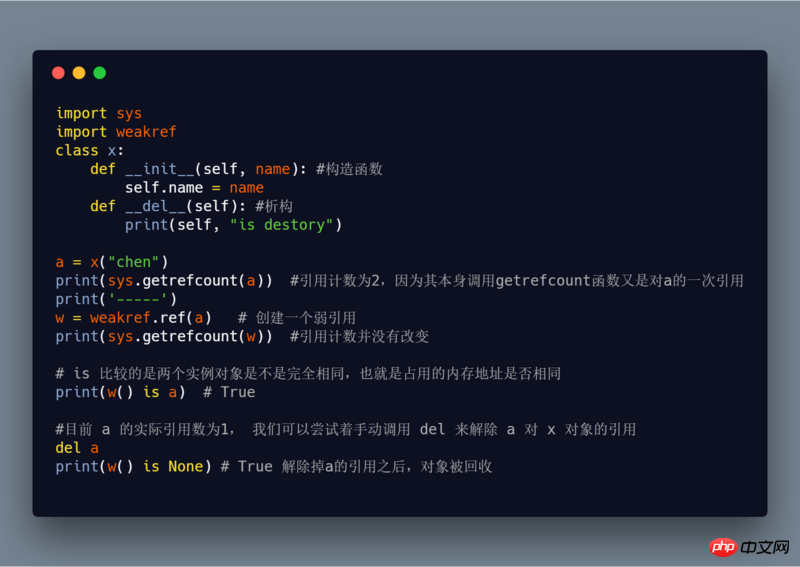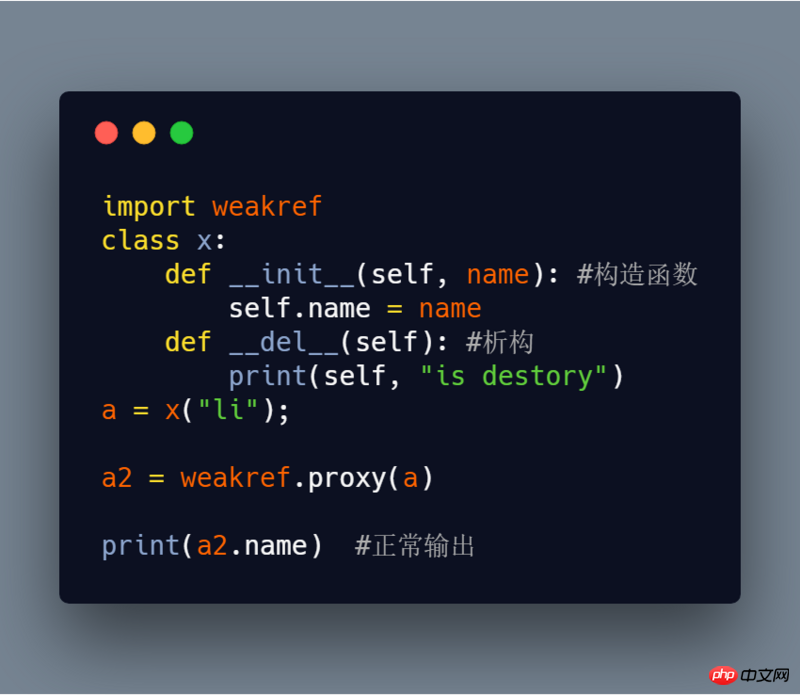 Backend Development
Backend Development
 Python Tutorial
Python Tutorial
 A simple understanding of python reference counting and weak references (with examples)
A simple understanding of python reference counting and weak references (with examples)
A simple understanding of python reference counting and weak references (with examples)
This article brings you a simple understanding of python reference counting and weak references (with examples). It has certain reference value. Friends in need can refer to it. I hope it will be helpful to you.
Written in front:
The previous socket series has come to an end, mainly to make a summary and record of what I have learned.
Next I plan to write an HTTP server that supports concurrency based on libevent. Because the master in the study group had already developed a server that supports both HTTP and WebSocket before, I felt very interested after reading it, so I bought this network programming book to read. I plan to refer to his to write a streamlined version,
only supports HTTP. After I finish writing it, I can share it with everyone. Although it cannot be used in a production environment, I believe that after learning the source code, it will be a great improvement for myself.
Next enter the topic:
First put the example code:

We create one for testing The x object includes a constructor and a destructor.
The x object is initialized for the first time and referenced by variable a, so the reference count here is 1. Then get the number of references through getrefcount, which here becomes 2, because calling the function getrefcount itself is also a reference to a.
Next, create a weak reference through weakref.ref(). After printing the reference count through getrefcount, it is found that the count has not changed.
w() is a This sentence means to determine whether the two instances are exactly the same, that is, whether they occupy the same memory address.
Then we use del a to dereference a to the x object. Note that del here does not directly recycle the x object, but dereferences it. We know that once the reference of a variable is 0, it will be Recycle. So the x object is recycled after calling del.
Through the previous code, we can see that the method of calling weak references is the method of class functions. However, you can use proxy to call using variable names instead.

At this point I believe that I have definitely mastered the use of weak references. But what exactly does a weak reference do?
Like many other high-level languages, Python also has a garbage collection mechanism. Each object has a reference count, and when this count reaches 0, the object can be safely destroyed.
Since only one object can be recycled at a time, reference counting cannot recycle objects with circular references. A set of objects that reference each other will survive forever if they are not directly referenced by other objects and are inaccessible.
If an application continues to generate such inaccessible object groups, a memory leak will occur.
So weak references are very suitable for handling this kind of circular reference scenario.
The above is the detailed content of A simple understanding of python reference counting and weak references (with examples). For more information, please follow other related articles on the PHP Chinese website!

Hot AI Tools

Undresser.AI Undress
AI-powered app for creating realistic nude photos

AI Clothes Remover
Online AI tool for removing clothes from photos.

Undress AI Tool
Undress images for free

Clothoff.io
AI clothes remover

Video Face Swap
Swap faces in any video effortlessly with our completely free AI face swap tool!

Hot Article

Hot Tools

Notepad++7.3.1
Easy-to-use and free code editor

SublimeText3 Chinese version
Chinese version, very easy to use

Zend Studio 13.0.1
Powerful PHP integrated development environment

Dreamweaver CS6
Visual web development tools

SublimeText3 Mac version
God-level code editing software (SublimeText3)

Hot Topics
 PHP and Python: Different Paradigms Explained
Apr 18, 2025 am 12:26 AM
PHP and Python: Different Paradigms Explained
Apr 18, 2025 am 12:26 AM
PHP is mainly procedural programming, but also supports object-oriented programming (OOP); Python supports a variety of paradigms, including OOP, functional and procedural programming. PHP is suitable for web development, and Python is suitable for a variety of applications such as data analysis and machine learning.
 Choosing Between PHP and Python: A Guide
Apr 18, 2025 am 12:24 AM
Choosing Between PHP and Python: A Guide
Apr 18, 2025 am 12:24 AM
PHP is suitable for web development and rapid prototyping, and Python is suitable for data science and machine learning. 1.PHP is used for dynamic web development, with simple syntax and suitable for rapid development. 2. Python has concise syntax, is suitable for multiple fields, and has a strong library ecosystem.
 PHP and Python: A Deep Dive into Their History
Apr 18, 2025 am 12:25 AM
PHP and Python: A Deep Dive into Their History
Apr 18, 2025 am 12:25 AM
PHP originated in 1994 and was developed by RasmusLerdorf. It was originally used to track website visitors and gradually evolved into a server-side scripting language and was widely used in web development. Python was developed by Guidovan Rossum in the late 1980s and was first released in 1991. It emphasizes code readability and simplicity, and is suitable for scientific computing, data analysis and other fields.
 Python vs. JavaScript: The Learning Curve and Ease of Use
Apr 16, 2025 am 12:12 AM
Python vs. JavaScript: The Learning Curve and Ease of Use
Apr 16, 2025 am 12:12 AM
Python is more suitable for beginners, with a smooth learning curve and concise syntax; JavaScript is suitable for front-end development, with a steep learning curve and flexible syntax. 1. Python syntax is intuitive and suitable for data science and back-end development. 2. JavaScript is flexible and widely used in front-end and server-side programming.
 How to run sublime code python
Apr 16, 2025 am 08:48 AM
How to run sublime code python
Apr 16, 2025 am 08:48 AM
To run Python code in Sublime Text, you need to install the Python plug-in first, then create a .py file and write the code, and finally press Ctrl B to run the code, and the output will be displayed in the console.
 Can vs code run in Windows 8
Apr 15, 2025 pm 07:24 PM
Can vs code run in Windows 8
Apr 15, 2025 pm 07:24 PM
VS Code can run on Windows 8, but the experience may not be great. First make sure the system has been updated to the latest patch, then download the VS Code installation package that matches the system architecture and install it as prompted. After installation, be aware that some extensions may be incompatible with Windows 8 and need to look for alternative extensions or use newer Windows systems in a virtual machine. Install the necessary extensions to check whether they work properly. Although VS Code is feasible on Windows 8, it is recommended to upgrade to a newer Windows system for a better development experience and security.
 Where to write code in vscode
Apr 15, 2025 pm 09:54 PM
Where to write code in vscode
Apr 15, 2025 pm 09:54 PM
Writing code in Visual Studio Code (VSCode) is simple and easy to use. Just install VSCode, create a project, select a language, create a file, write code, save and run it. The advantages of VSCode include cross-platform, free and open source, powerful features, rich extensions, and lightweight and fast.
 Can visual studio code be used in python
Apr 15, 2025 pm 08:18 PM
Can visual studio code be used in python
Apr 15, 2025 pm 08:18 PM
VS Code can be used to write Python and provides many features that make it an ideal tool for developing Python applications. It allows users to: install Python extensions to get functions such as code completion, syntax highlighting, and debugging. Use the debugger to track code step by step, find and fix errors. Integrate Git for version control. Use code formatting tools to maintain code consistency. Use the Linting tool to spot potential problems ahead of time.





